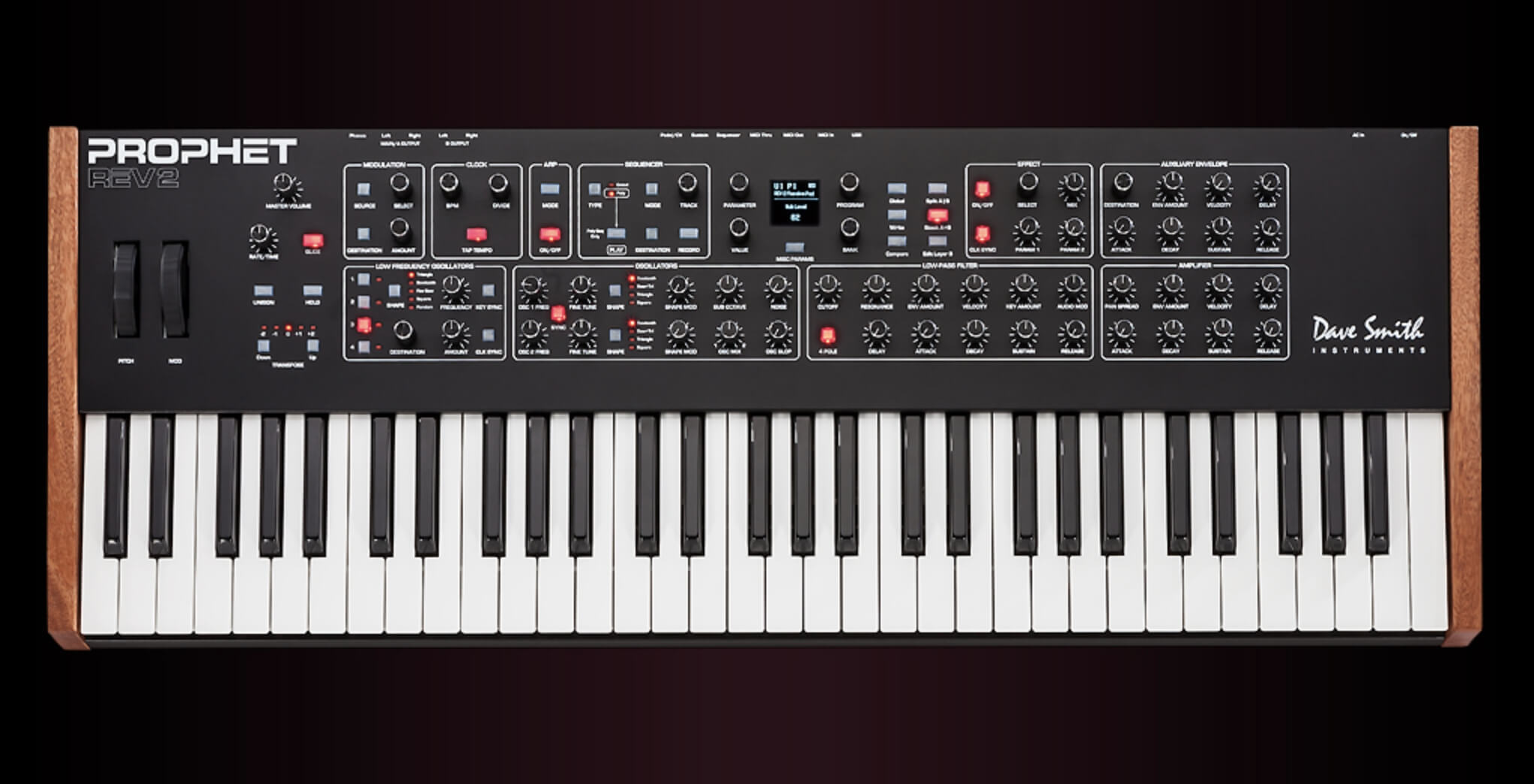
Features:
- A real analog synth that continues the Prophet legacy
- Wide variety of sounds attainable through splits and layers
- 16-voice monster spec!
- Equipped with arpeggiator & polyphonic sequencer
The even more powerful Prophet REV2
Dave Smith Instruments has released another synth in their Prophet line, this time one that's been powered up.
In the Prophet08 series, we saw the return of the Prophet name, and the return of analog sound, with an 8-voice analog synth that got popular overnight. Later, the Prophet-6 was released, which was a 6-voice analog synth that re-imagined the vintage Prophet-5. Today, a new, powered up version arrives as the Prophet REV2.

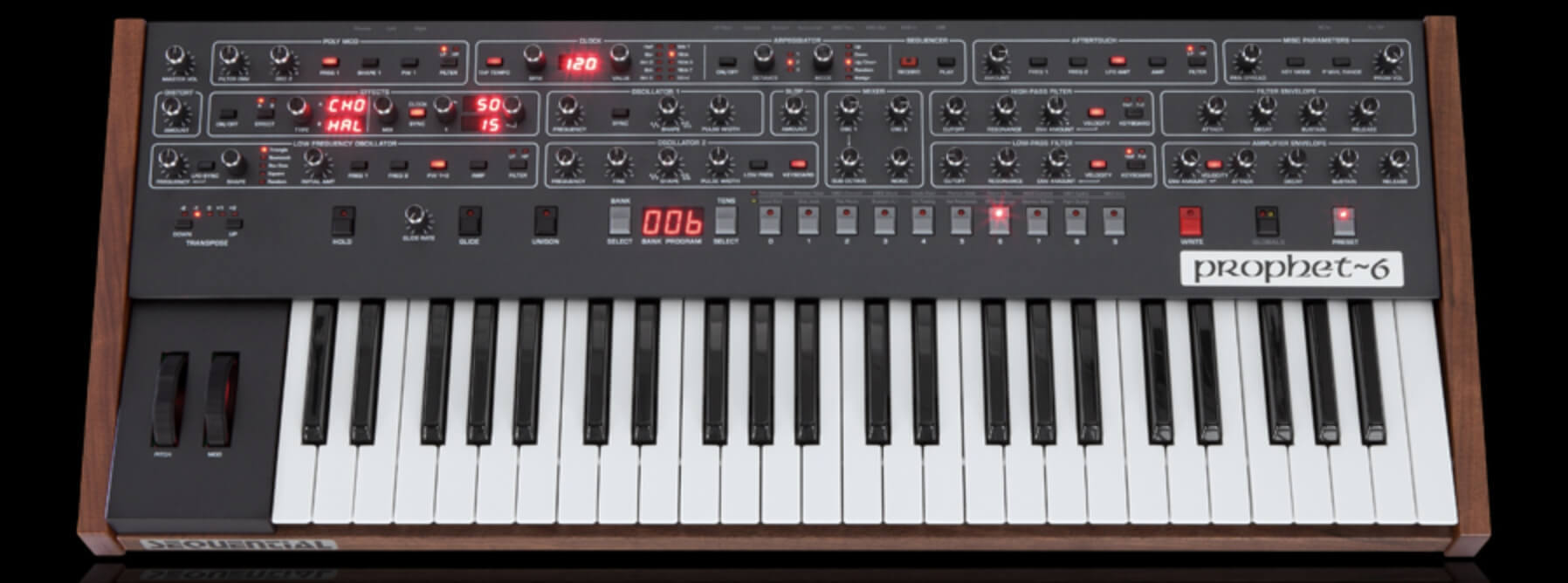
Demo & Review Video
First of all, check the video to see what it can do, and just how good it sounds.
Differences from previous Prophets
What did you think of the sound?
Layer sounds make the most of the Prophet REV2's 16 voices, for a sound that just has ANALOG written all over it.
How is this version different from previous Prophets?
Prophet '08
After the Evolver, the first synth to be released with the Prophet name was the Prophet '08—a 100% analog signal path, analog circuit, polyphonic synth. If anything, the impression was that this synth was more a return of a good-sounding analog poly synth, which was seen by longtime Prophet users as a different analog synth wearing the Prophet name.
Prophet-6
Next, the Prophet-6 was released. Design-wise, it was inspired by the Prophet-5, with focus on virtually re-creating that synth. As a result, the filter is very close to that of the original. The shape of the knobs, the position and shape of the buttons, even the panel design is close to the original, and it even has the preset sounds from the original!
Prophet12
The Prophet12 is different from either of the above synths, in that it uses DSP for virtual analog oscillators. As such, we can't easily compare and contrast here. The filter is analog though. Sure enough, digital power shows through in areas such as modulation, flexibility of the matrix, the effects, wave shaping and so on, so for those after the widest variety of sounds, we think the Prophet-12 has the strongest personality of the lot.
Even though these synths are all members of the Prophet series, there are differences between them, as we've touched on above. In the case of the Prophet REV2, just from looking at the specs it would appear that it is a descendant of the Prophet '08.
Oscillator Section
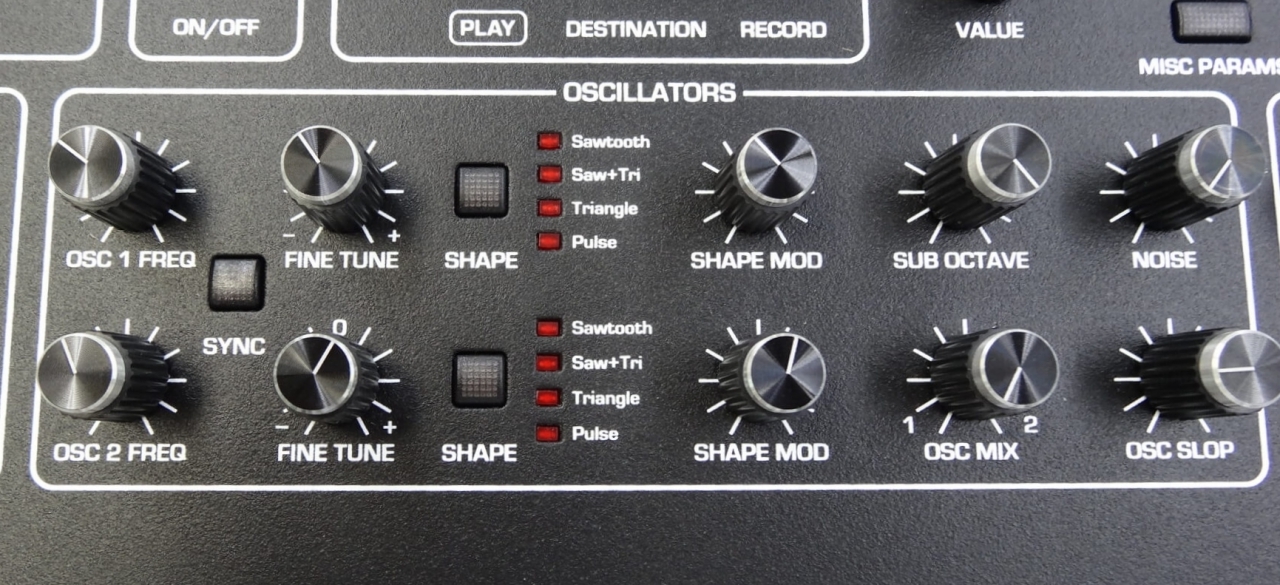
For oscillators, the REV2 is equipped with two DCOs: Digitally Controlled Oscillators. What might not be obvious from the name is that these are digitally controlled analog oscillators, as such they do not suffer from tuning instability resulting from fluctuations in voltage. DCOs are actually quite common in today's new analog synths.
SHAPE
- Sawtooth
- Saw+Tri
- Triangle
- Pulse
Both Oscillators have four waveforms, which can be synced.
NOISE
Noise Generator
SHAPE MOD
Waveshaping is available on both oscillators. Through shaping the oscillators, a number of different waveforms can be created. Also, modulation can be applied here, for example, if you route an LFO to wave shape you can get a continually changing waveform. In this regard, the color of this Prophet is a bit different from previous models.
SUB OCTAVE
Sub Oscillator
OSC SLOP
This is a parameter we're not used to seeing. What it does is apply a subtle variation to each oscillator every time a key is struck, which provides a more analog-like feel. This is really a parameter of the times, which can be used for re-creating vintage analog instability, or bringing instability to the forefront.
Filter Section

The filter of the Prophet Rev2 is a Curtis lowpass filter which can be adjusted per voice, and is 2- or 4-pole selectable.
Curtis filter chips were used during the 70s and 80s in a number of synthesizers including the Prophet-5.
As with the previous model (the Prophet '08), they've used the best elements of vintage analog synths, which we think is why they chose Curtis filters. The Prophet filters are well-known for not thinning out when the resonance is cranked. What's more, when set to 4-pole, the filter can self-oscillate without passing the oscillators through.
The envelopes are ADSR plus Delay, for finer control.
Other features include basic synthesizer parameters such as ENV AMOUNT, VELOCITY, KEY AMOUNT, as well as POLY MOD (you'd almost not be able to call it a Prophet without it) and AUDIO MOD too.
Effects
Above the Filter Section you will find the Effects Section. Back in the day, running vintage analog synths through a series of outboard effects processors in order to get a rich sound during recording and what not was a matter of course. But almost all of today's synths come equipped with on-board effects processors.
Play Mode
We've chosen to call the area to the left of the Effects Section the Play Mode, which is used to define Program Mode while playing.
Global / Write / Compare / Edit Layer B
Here you find controls for global settings, program editing and storing, and other operation-related parameters.
Split A | B
Stack A + B
Here are unique features of the Prophet Rev2.
Programs can be split or stacked, and you can make some very rich sounds if you make the most of these functions. With the power of 16 voices, you could stack two six-voice sounds on top of each other, or make a split with a bass sound on the left and a backing sound on the right. These features are great for a variety of performance styles.。
PROGRAM / BANK
The program selector is a rotary dial. There are 512 factory programs and 512 user programs, which together make a staggering total amount of sounds. Also, the OLED display is great, and very easy to read.
Amp/Auxiliary Envelope
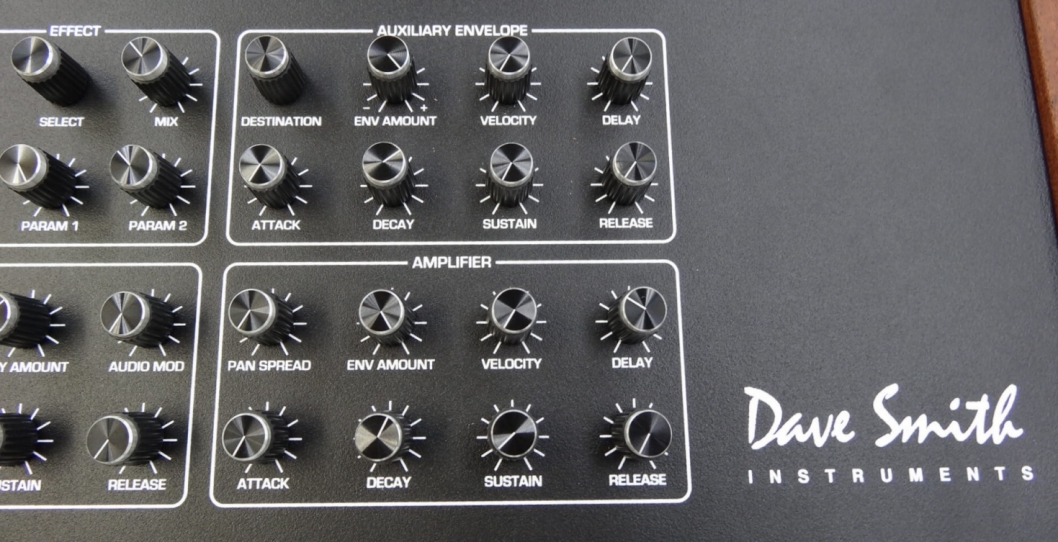
Amp Envelope
The Amp Envelope is an ADSR with Delay.
Other controllable features include ENV AMOUNT and VELOCITY. A special feature here is the PAN SPREAD parameter. Each oscillator can be spread across the stereo panorama each time a key is pressed. The Spread and Depth parameters are definable, and when used effectively can add spaciousness to your sounds. A trick you could try: arpeggiate a sound with a short decay, send that through a delay, then tweak the Spread parameter to scatter the sound through the stereo sound field.
Auxiliary Envelope
This is the third Envelope, which is also an ADSR with Delay.
You can choose the Destination to be modulated by this envelope. And, since it is possible to control the Env Amount via Velocity, by changing the depth of the velocity control you've got some flexibility as to how you can put the envelope to use.
When routed to control the pitch of an Oscillator, you get a Pitch Envelope here. We think this might be the most common use of the Aux Envelope.
Other Sections
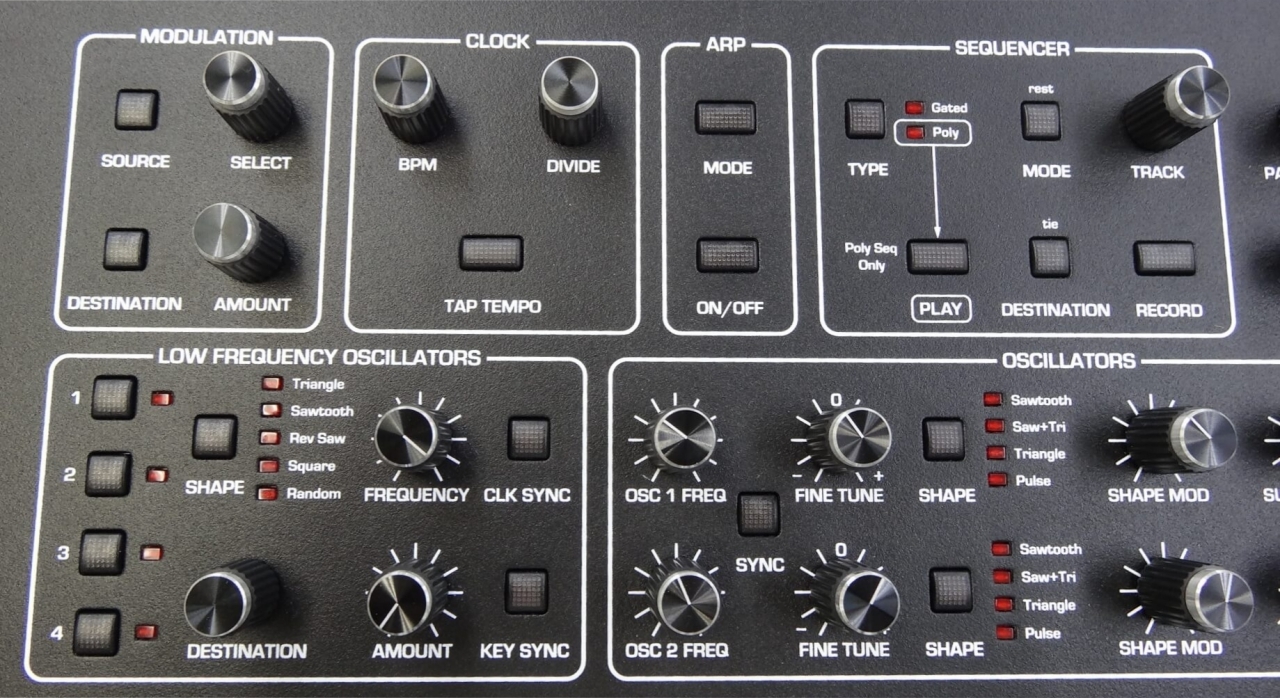
Modulation
There is an 8-slot, 22 source, 53 destination Mod Matrix.
This is twice the number of slots in the Prophet '08, which translates into a marked increase in the breadth of sounds that can be made when considering the modulation possibilities.
LFO
There are four independent LFOs. You can select a waveform via SHAPE, speed via FREQUENCY, and level of the LFO via AMOUNT.
Waveforms are Triangle, Sawtooth, Rev Saw, Square, and Random. Speed can be synced to external clock, and key-on.
Clock
This is where you control the clock for the Arpeggiator and Poly Sequencer. Tap Tempo function included.
Arpeggiator/Sequencer

Arpeggiator
The Arpeggiator has five modes: Up, Down, UP+Down, Random, Assign. It can be set to 16th notes, 8th note triplets, 8th notes, dotted 8th notes or quarter notes. Other controllable features include note repeat, re-latch, BPM, clock divide, and so on. The Arpeggiator tempo can be set to sync to an external MID clock source.
Polyphonic Step Sequencer
A total of up to 64 steps can be programmed for each track of the sequencer. Also, up to 6 notes can be entered for each individual step, so when using stack or split modes, each layer can be doing a different sequence. This is a very powerful performance tool!
Gate Sequencer
4 tracks of up to 16 steps each can be programmed here. Controllable destinations include note data, modulation sources, filter cutoff, oscillator shape and so on, so up to four tracks of modulation can be controlled from this sequencer.
Ties and rests can be programmed in both sequencers, and they can also be synced to external (MIDI) clock.
Controllers
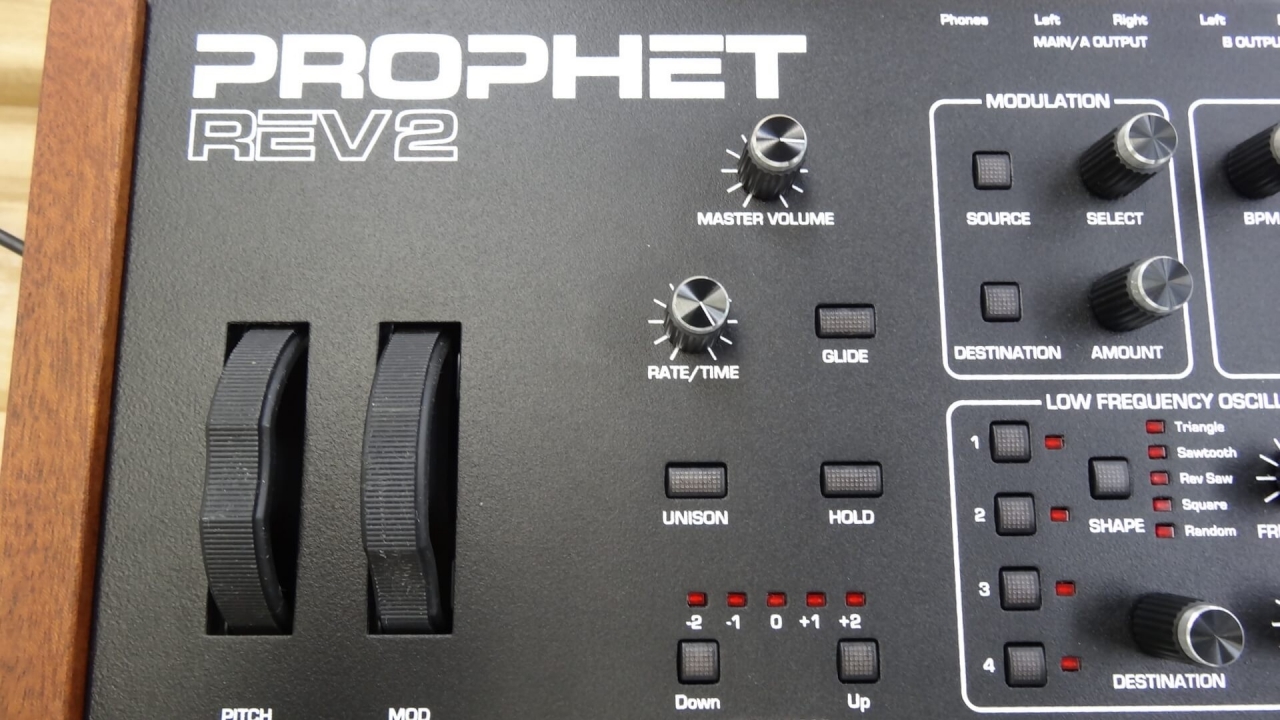
The controller section is where you'll find the mod wheel and the pitch bender, at the far left side of the front panel.
The Master Volume control is located here as well, and not to the right of the Amp section so it's rather convenient.
Other controls include Glide, Portamento, Hold, Transpose, and Unison, which on this 16-voice 32-oscillator synth is a real beast.
Cost Performance
We think it should be obvious that the Prophet REV2 is a serious upgrade to the already fantastic feature set of the Prophet '08.
What's more surprising is that the price has actually dropped compared to when the Prophet '08 was released. Variations of the Prophet REV2 include the 8-voice version, and the desktop module version. But if you really want to make the most of this synth's powerful features, the best bet is to go with the 16-voice keyboard model.
In contrast to the vintage Prophet, the REV2 is very stable, not prone to breaking down, and in the event that it does break down it can easily be sent in for repair. Unless you're peculiarly picky, buying the REV2 is a no-brainer, as you will easily get lots of mileage out of it for many years to come. You really need to sit down and play with one at a dealer near you.